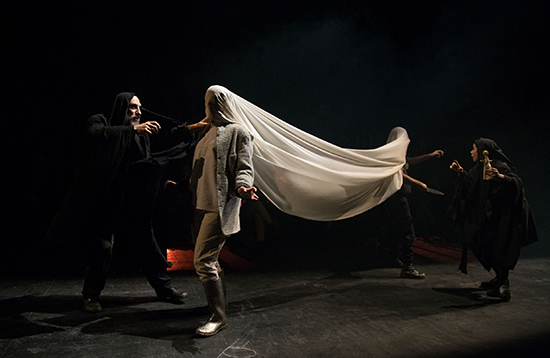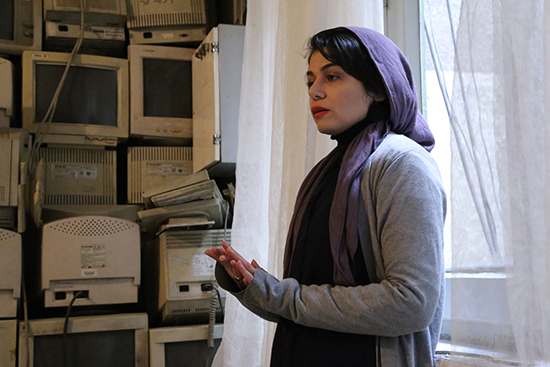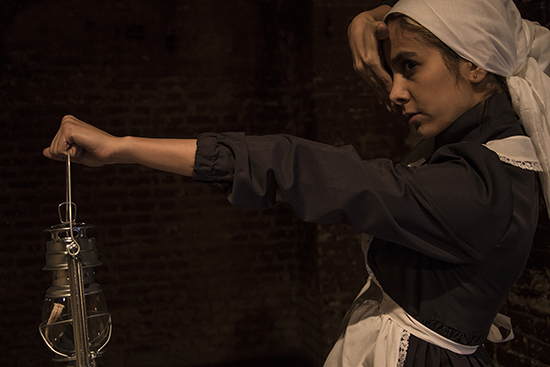Iran onstage
Megan Garrett-Jones: 35th Fadjr International Theatre Festival

Diabolic Romeo & Juliet, Fadjr International Theatre Festival
A stocky, bearded man in a soldier’s uniform drips with sweat midway through a physically demanding performance of Dario Fo’s one-hander The Tale of the Tiger. He is a well-known Iranian actor, Hedayat Hashemi, and we are in a small ‘salon’ of the City Theatre of Tehran. Every now and then I catch a phrase with my very limited understanding of Farsi. “Kabab mikonam” (“I make kebab”), he repeats when the mother tiger has entrapped him in domestic service upon discovering she and her cub prefer their meat barbecued.
Despite the language barrier, Hashemi’s physical rendering of every character and event is understandable and hilarious. As he becomes a small-statured Chinese leader, standing on tiptoes to peer over an imaginary counter, one of the translators assigned to our group of foreign visitors leans over to me and whispers, “he is making fun of our former president, Ahmadinejad.” This show exemplified what impressed me about the Iranian theatre I saw during the Fadjr Festival, namely highly skilled performances, a mastery of storytelling and the subtle political jab.
The Fadjr Festival
Now in its 35th year, the Fadjr Festival embodies some of the contradictions of modern-day Iran. It is a state-sponsored festival that marks the return of Ayatollah Khomeini to lead the new Islamic Republic after the 1979 revolution. Tehran also has notable film and music festivals, and a visual arts program that is less notable, not for want of impressive Iranian artists, but their ambivalence towards participating. It seems there would be barriers to establishing an internationally-positioned theatre sector in Iran, such as strained diplomatic relations, the subsequent difficulty for some in travelling in or out of Iran and the extent to which the arts are censored and controlled. However, Iranian theatre practitioners have responded with a focus on developing home-grown talent, while the works themselves engage with contemporary forms, international influences and Iran’s cultural history.
The Unhealable Wound
Theatre as it is known today (as opposed to folk performance of mainly music and poetry) is relatively recent to Iran, dating back about 100 years to the Qajar dynasty’s first embrace of Western culture. The traditions established then involved high melodrama, archetypal characters and the integration of traditional music, which could still be seen in some of the shows in Fadjr, such as The Unhealable Wound directed by Afsaneh Zamani. Its set of four wooden columns and joining platforms evokes Qajar architecture, with sheer curtains suggesting veiling and traditional modesty. The setting is the women’s sanctum of a noble household, however a man has been admitted—a revolutionary in hiding who is also a musician. He and the female protagonist, Malek, build a romance through their love of singing. Malek also plays something of a clown to entertain her sister. In a convoluted plot, the sister also falls for the revolutionary, an older matriarch interferes and Malek, in a fit of jealousy, sells out the man to the police. The acting is over the top—Iran first adopted western dramatic forms when melodrama flourished in Europe—but enjoyable and highly skilled.
The Trumpet of Israfil
There was a definite tendency towards adaptation and appropriation in the festival’s “Stage Plays” program. The production of The Trumpet of Israfil, based loosely on Hungarian novelist Ágota Kristóf’s The Notebook, adopts a European period aesthetic evoking the book’s World War II setting. This was despite the title’s reference to the Islamic archangel Uriel among other culturally incongruent references, like the Priest in his long, black cloak and white clerical collar reading from the Quran. The protagonist is a young boy of about 10, yet he refers to himself as “we” in an ambiguous nod to the twin boy narrators in the book. It is a striking performance from the child actor, Illia Nasrollahi, who observes cruel events with an often chilling blankness or a precociousness inviting laughter. The stage design is quite modern, consisting of a circular platform with a revolving outer section yielding seamless scene changes and at times a sense of travel or time passing. The plot is a watered down version of Kristóf’s novel, omitting rape, violence and paedophilia and employing euphemisms for vaguely salacious events, such as a scene that opens with the affable ‘crazy girl’ waking in the officer’s bed with her heavy lipstick now smeared across her face. The Trumpet of Israfil is a likable and well-crafted example of mainstream theatre.
Diabolic Romeo and Juliet
Diabolic Romeo and Juliet moves into another European tradition, that of the postmodern auteur director, by way of actor turned director Atilla Pessyani and a significant rewriting of Shakespeare’s play (with English surtitles). A traverse stage becomes a road, a no-man’s-land where the warring Montagues and Capulets converge. The cast lie on stage, wrapped in white shrouds and are stirred by a strange priest, seemingly recommencing a cycle of war and death. The families are warring drug barons and small packets of white powder induce a high and erratic state in the young lovers throughout. Juliet is a badass in sparkly gumboots and weapons take on an erotic charge. As they confront each other, Juliet brushes her knife across Romeo’s cheek. Characters killed in various skirmishes return as the undead, puppet-like and, having shed their allegiances, join in with commentary and prophesies of doom. Adding to the dark tone is a live soundtrack in which moody keyboards and rumbling electronic effects are mixed with a traditional bagpipe and a lament sung by one of the actors. Addressing the audience before the show, the director informs us that the actors playing Romeo and Juliet are siblings, making a point of the lengths gone to bypass restrictions like the one forbidding male and female actors from touching onstage.
With most of the 20 international productions in the festival sold out and the seeming impossibility of obtaining a media pass, I joined up with a group of invited European presenters and was taken to almost exclusively Iranian theatre. So it was hard to gauge how overall content was programmed. I did see an outdoor production from a Polish group, directed by Jerzy Zon, which sat somewhere between epic spectacle and avant-garde street theatre. The appetite for European avant-garde was confirmed in a visit by Eugenio Barba to Tehran in the week following the festival that included a workshop program attracting over 400 Iranian students.
Beyond the “Stage Plays” was a program of environmental and public works. These were largely performances on outdoor stages such as the one in the forecourt of the City Theatre set up in the Iranian tradition of Ru Howzi (literally “on the fountain”), in which a public fountain is boarded-over to make a stage, often for lewd, festive comedy.

Butterfly, Fadjr International Theatre Festival
photo Kariz Arts
Butterfly, Fadjr International Theatre Festival
Butterfly
A more contemporary site-specific work was Butterfly (written and directed by Hossein Tavazonizadeh), performed for three audience members at a time in an abandoned stately building in the centre of Tehran. As we enter we are handed sweets and flowers to give as gifts, suggestive of the conventions of an Iranian marriage proposal. Initially we are cast as guests in a family home, blurring the distinction between the performers (three women and on this occasion a translator) and the audience. As we are led through the rooms, a story unfolds and we slip into roles of confidants and voyeurs. The space is made strange by the arrangement of furniture and detritus, perhaps from the building’s former use, such as a wall piled high with antique computer monitors, which sets the scene. The central character Parvaneh tells us about a boy she wants to marry who has studied IT.
According to the program the work is about the taboos surrounding intellectual disability and autism, however the theme of isolation and fantasy embodied in Parvaneh could apply to anyone trapped in a domestic space or considered an outsider. Butterfly is an intimate experience where the magic of the space is sensitively merged with the company’s poetic storytelling.
The Maids
Aside from consistently full houses at the main stage plays, an indication of the vibrancy of Tehran’s theatre scene was the large “Fadjr Plus” program, showing emerging and experimental works across a number of smaller and independent venues. Despite performance of dance being currently banned in Iran, a production of Jean Genet’s The Maids was billed as being of “body and movement repertoire.” In a series of choreographed exchanges in the dark cavernous space of Da Theatre (once a public bathhouse), two performers (Reyhaneh Nabiiyan and Maral Ostadi) play out the sinister plot of two maids planning to kill their mistress. They feel out the space by running rubber-gloved hands over the brick walls like spiders, crumbling mortar and making dust. Cleaning motions morph into violent and erotic games. There is a little bit of heavy-handed symbolism, but the relationship between the two and to the outside aggressor is clearly established and explored for its tension and drama.
The Fadjr International Theatre Festival reveals the esteem that theatre has garnered in Iran as a valuable means of expression extending rich artistic traditions. There is a sense of theatre craft being mastered, of the harnessing of its social power insofar as is permitted. It was heartening too, to see so much activity from the next generation of performance makers, who will no doubt continue to look for ways to push boundaries.

The Maids, Fadjr International Theatre Festival
photo Saeed Jalli & Reyhane Nabiyan
The Maids, Fadjr International Theatre Festival
The 35th Fadjr International Theatre Festival, Director Saeed Asadi, Tehran, 20-31 Jan
RealTime issue #137 Feb-March 2017






